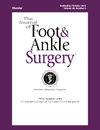Clinical outcome of the ilizarov fixator combined with telescopic rod technique to reverse anterior subluxation of the talus during the correction of equinocavovarus deformity
IF 1.3
4区 医学
Q2 Medicine
引用次数: 0
Abstract
The effectiveness of the Ilizarov technique combined with telescopic rod technique in the treatment of equinocavovarus foot deformities in adults was undefined. All 72 adult patients (76 feet) who underwent the Ilizarov technique combined with telescopic rod technique for correction of equinovarus foot deformities between February 2012 and May 2022 were included. Clinical outcomes were assessed preoperatively and at the last follow-up by the Visual Analog Scale (VAS), the American Orthopaedic Foot and Ankle Society (AOFAS) ankle-hind foot score, and the Short Form-36 (SF-36) questionnaire. The radiographic outcomes were measured on weight-bearing ankle and foot radiographs taken preoperatively and at the last follow-up. The postoperative VAS and AOFAS ankle-hind foot scores significantly improved compared to the preoperative (P < 0.0001 for each). The postoperative SF-36 scores significantly increased referring to physical function, role-physical, body pain, general health, vitality, social function, role-emotional, mental health, and health transition (P < 0.0001 for each). Early complications were found in 20 feet (27 %) and late complications were found in 8 feet (10.8 %). In addition, the postoperative tibio-talar angle, tibial-sole angle, talus-first metatarsal angle, talo-calcaneal angle and hindfoot alignment view angle significantly improved compared to the preoperative. Sixty-three (87.5 %) patients were satisfied with the treatment effect. The Ilizarov technique combined with telescopic rod technique is an effective and reliable method in correcting equinocavovarus foot deformity, with high satisfaction and few complications.
Ilizarov固定器联合伸缩杆技术矫正马前翻畸形时距骨前半脱位的临床疗效。
Ilizarov技术联合伸缩杆技术治疗成人马蹄内翻足畸形的有效性尚不明确。在2012年2月至2022年5月期间,所有72名(76英尺)接受Ilizarov技术联合伸缩棒技术矫正马蹄内翻足畸形的成年患者均被纳入研究。采用视觉模拟量表(VAS)、美国矫形足踝学会(AOFAS)踝后足评分和SF-36问卷对术前和末次随访的临床结果进行评估。通过术前和最后随访时拍摄的负重踝关节和足部x线片测量放射学结果。术后VAS和AOFAS踝后足评分较术前显著提高(P < 0.0001)。术后SF-36评分在身体功能、角色-身体、身体疼痛、一般健康、活力、社会功能、角色-情感、心理健康和健康转变方面均显著升高(P < 0.0001)。早期并发症出现在20英尺(27%),晚期并发症出现在8英尺(10.8%)。此外,术后胫距角、胫掌角、距骨-第一跖骨角、距骨-跟骨角和后足对准视角较术前有明显改善。63例(87.5%)患者对治疗效果满意。Ilizarov技术联合伸缩棒技术是一种有效可靠的矫正马蹄内翻足畸形的方法,满意度高,并发症少。证据等级:四级,回顾性研究。
本文章由计算机程序翻译,如有差异,请以英文原文为准。
求助全文
约1分钟内获得全文
求助全文
来源期刊

Journal of Foot & Ankle Surgery
ORTHOPEDICS-SURGERY
CiteScore
2.30
自引率
7.70%
发文量
234
审稿时长
29.8 weeks
期刊介绍:
The Journal of Foot & Ankle Surgery is the leading source for original, clinically-focused articles on the surgical and medical management of the foot and ankle. Each bi-monthly, peer-reviewed issue addresses relevant topics to the profession, such as: adult reconstruction of the forefoot; adult reconstruction of the hindfoot and ankle; diabetes; medicine/rheumatology; pediatrics; research; sports medicine; trauma; and tumors.
 求助内容:
求助内容: 应助结果提醒方式:
应助结果提醒方式:


